| Article ID | Journal | Published Year | Pages | File Type |
|---|---|---|---|---|
| 5539771 | Behavioural Processes | 2017 | 16 Pages |
Abstract
The visual sense of dogs is in many aspects different than that of humans. Unfortunately, authors do not explicitly take into consideration dog-human differences in visual perception when designing their experiments. With an image manipulation program we altered stationary images, according to the present knowledge about dog-vision. Besides the effect of dogs' dichromatic vision, the software shows the effect of the lower visual acuity and brightness discrimination, too. Fifty adult humans were tested with pictures showing a female experimenter pointing, gazing or glancing to the left or right side. Half of the pictures were shown after they were altered to a setting that approximated dog vision. Participants had difficulty to find out the direction of glancing when the pictures were in dog-vision mode. Glances in dog-vision setting were followed less correctly and with a slower response time than other cues. Our results are the first that show the visual performance of humans under circumstances that model how dogs' weaker vision would affect their responses in an ethological experiment. We urge researchers to take into consideration the differences between perceptual abilities of dogs and humans, by developing visual stimuli that fit more appropriately to dogs' visual capabilities.
Keywords
Related Topics
Life Sciences
Agricultural and Biological Sciences
Animal Science and Zoology
Authors
Péter Pongrácz, Vera Ujvári, Tamás Faragó, Ádám Miklósi, András Péter,
